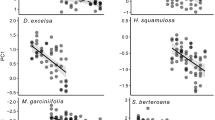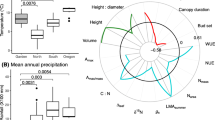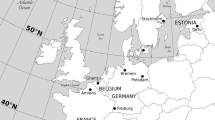Abstract
An unanswered question in ecology is whether the environmental factors driving short-term performance also determine the often observed long-term performance differences among individuals. Here, we analyze the extent to which temporal persistence of spatial heterogeneity in environmental factors can contribute to long-term inter-individual variation in stem length growth. For a natural population of a long-lived understorey palm, we first quantified the effect of several environmental factors on stem length growth and survival. We then performed individual-based simulations of growth trajectories, in which we varied, for two environmental factors: (1) the strength of the effect on stem length growth and (2) the temporal persistence. Short-term variation in stem length growth was strongly driven by light availability. Auto-correlation in light availability and soil pH increased simulated variation in stem length growth among 20-year-old palms to levels similar to the observed variation. Analyses in which we varied both the strength of the effect on stem length growth and the temporal persistence of the environmental factors revealed that a large fraction of observed long-term growth differences can be explained, as long as one of these effects is strong. This implies that environmental factors that are relatively unimportant for short-term performance can still drive long-term performance differences when the environmental variation is sufficiently persistent over time.





Similar content being viewed by others
References
Barton K (2015) MuMIn: Multi-Model Inference. R package version 1.13.4
Berry EJ, Gorchov DL, Endress BA, Stevens MHH (2008) Source-sink dynamics within a plant population: the impact of substrate and herbivory on palm demography. Popul Ecol 50:63–77. doi:10.1007/s10144-007-0067-z
Biggs HC (2003) The Kruger experience: ecology and management of savanna heterogeneity. Island Press, USA
Bongers F, Charles-Dominique P, Forget P-M, Théry M (2001) Nouragues: dynamics and plant-animal interactions in a neotropical rainforest. Springer, Berlin
Brienen RJW, Zuidema PA (2006) Lifetime growth patterns and ages of Bolivian rain forest trees obtained by tree ring analysis. J Ecol 94:481–493
Chazdon RL (1986) Light variation and carbon gain in rain forest understorey palms. J Ecol. doi:10.2307/2260229
Chazdon RL (1988) Sunflecks and their importance to forest understorey plants. Adv Ecol Res 18:1–63. doi:10.1016/S0065-2504(08)60179-8
Chazdon R, Fetcher N (1984a) Light environments of tropical forests. Physiological ecology of plants of the wet tropics. Springer, Berlin, pp 27–36
Chazdon RL, Fetcher N (1984b) Photosynthetic light environments in a lowland tropical rain forest in Costa Rica. J Ecol. doi:10.2307/2260066
Clark DB, Clark DA, Rich PM (1993) Comparative analysis of microhabitat utilization by saplings of nine tree species in neotropical rain forest. Biotropica. doi:10.2307/2388863
Connell JH (1978) Diversity in tropical rain forests and coral reefs. Science 199:1302–1310
Crowther J (1982) Ecological observations in a tropical karst terrain, West Malaysia. I. Variations in topography, soils and vegetation. J Biogeography. doi:10.2307/2844731
de Kroon H et al (2012) Root responses to nutrients and soil biota: drivers of species coexistence and ecosystem productivity. J Ecol 100:6–15. doi:10.1111/j.1365-2745.2011.01906.x
Denslow JS, Ellison AM, Sanford RE (1998) Treefall gap size effects on above-and below-ground processes in a tropical wet forest. J Ecol 86:597–609. doi:10.1046/j.1365-2745.1998.00295.x
Dubbin WE, Penn MG, Hodson ME (2006) Edaphic influences on plant community adaptation in the Chiquibul forest of Belize. Geoderma 131:76–88
Ellner SP, Rees M (2006) Integral projection models for species with complex demography. Am Nat 167:410–419. doi:10.1086/499438
Guariguata MR, Sist P, Nasi R (2012) Multiple use management of tropical production forests: How can we move from concept to reality? For Ecol Manag 263:170–174. doi:10.1016/j.foreco.2011.09.032
Hodel DR (1992) Chamaedorea palms, the species and their cultivation. Allen Press, Lawrence
Ibarra-Manríquez G, Martínez-Ramos M (2002) Landscape variation of liana communities in a Neotropical rain forest. Plant Ecol 160:91–112. doi:10.1023/A:1015839400578
Jansen M, Zuidema PA, Anten NPR, Martínez-Ramos M (2012) Strong persistent growth differences govern individual performance and population dynamics in a tropical forest understorey palm. J Ecol 100:1224–1232. doi:10.1111/j.1365-2745.2012.02001.x
Jaramillo VJ, Detling JK (1992) Small-scale heterogeneity in a semi-arid North American grassland II Cattle grazing of simulated urine patches. J Applied Ecol. doi:10.2307/2404340
Kleb HR, Wilson SD (1997) Vegetation effects on soil resource heterogeneity in prairie and forest. Am Nat 150:283–298. doi:10.1086/286066
Li L et al (2007) Diversity enhances agricultural productivity via rhizosphere phosphorus facilitation on phosphorus-deficient soils. Proc Natl Acad Sci 104:11192–11196. doi:10.1073/pnas.0704591104
Martinez-Ramos M, Alvarez-Buylla E, Sarukhan J, Pinero D (1988) Treefall age determination and gap dynamics in a tropical forest. J Ecol. doi:10.2307/2260568
Martínez-Ramos M, Anten NPR, Ackerly DD (2009) Defoliation and ENSO effects on vital rates of an understorey tropical rain forest palm. J Ecol 97:1050–1061. doi:10.1111/j.1365-2745.2009.01531.x
Matos DM (2000) Herbivore and plant demography: a case study in a fragment of semi-deciduous forest in Brazil. J Trop Ecol 16:159–165
McLean E (1982) Soil pH and lime requirement. Methods of soil analysis. Part 2. Chemical and microbiological properties: 199–224
Nagelkerke NJD (1991) A note on a general definition of the coefficient of determination. Biometrika 78:691–692
Nicotra AB, Chazdon RL, Iriarte SV (1999) Spatial heterogeneity of light and woody seedling regeneration in tropical wet forests. Ecology 80:1908–1926. doi:10.1890/0012-9658(1999)080[1908:SHOLAW]2.0.CO;2
Pinard M (1993) Impacts of stem harvesting on populations of Iriartea deltoidea (Palmae) in an extractive reserve in Acre, Brazil. Biotropica 25:2–14. doi:10.2307/2388974
Piñero D, Sarukhán J (1982) Reproductive Behaviour and Its Individual Variability in a Tropical Palm, Astrocaryum Mexicanum. J Ecol 70:461–472. doi:10.2307/2259915
Plard F, Bonenfant C, Delorme D, Gaillard JM (2012) Modeling reproductive trajectories of roe deer females: fixed or dynamic heterogeneity? Theor Popul Biol 82:317–328. doi:10.1016/j.tpb.2012.03.006
Poorter L, Arets EJ (2003) Light environment and tree strategies in a Bolivian tropical moist forest: an evaluation of the light partitioning hypothesis. Plant Ecol 166:295–306. doi:10.1023/A:1023295806147
Poorter H, Niinemets Ü, Walter A, Fiorani F, Schurr U (2010) A method to construct dose–response curves for a wide range of environmental factors and plant traits by means of a meta-analysis of phenotypic data. J Exper Botany. doi:10.1093/jxb/erp358
R Development Core Team (2014) R: a language and environment for statistical computing. R Foundation for Statistical Computing, Vienna
Rousk J, Brookes PC, Bååth E (2009) Contrasting soil pH effects on fungal and bacterial growth suggest functional redundancy in carbon mineralization. Appl Environ Microbiol 75:1589–1596. doi:10.1128/AEM.02775-08
Snyder RE, Ellner SP, Metcalf CJE, Michalakis Y (2016) We happy few: using structured population models to identify the decisive events in the lives of exceptional individuals. Am Nat 188:E28–E45. doi:10.1086/686996
Steiner UK, Tuljapurkar S, Orzack SH (2010) Dynamic heterogeneity and life history variability in the kittiwake. J Anim Ecol 79:436–444. doi:10.1111/j.1365-2656.2009.01653.x
Sterck FJ, Clark DB, Clark DA, Bongers F (1999) Light fluctuations, crown traits, and response delays for tree saplings in a Costa Rican lowland rain forest. J Trop Ecol 15:83–95
Svenning JC (2002) Crown illumination limits the population growth rate of a neotropical understorey palm (Geonoma macrostachys, Arecaceae). Plant Ecol 159:185–199. doi:10.1023/A:101552011
Ulery A, Graham R, Amrhein C (1993) Wood-ash composition and soil pH following intense burning. Soil Sci 156:358–364
van der Meer PJ (1997) Vegetation development in canopy gaps in a tropical rain forest in French Guiana. Selbyana 18:38–50
Van der Meer P, Bongers F (1996) Formation and closure of canopy gaps in the rain forest at Nouragues, French Guiana. Vegetatio 126:167–179. doi:10.1007/BF00045602
Van Der Wal R, Egas M, Van Der Veen A, Bakker J (2000) Effects of resource competition and herbivory on plant performance along a natural productivity gradient. J Ecol 88:317–330. doi:10.1046/j.1365-2745.2000.00450.x
Van Nguyen T, Mitlöhner R, Van Bich N, Van Do T (2015) Environmental factors affecting the abundance and presence of tree species in a tropical lowland limestone and non-limestone forest in Ben En National Park, Vietnam. J For Environ Sci 31:177–191
Vindenes Y, Langangen O (2015) Individual heterogeneity in life histories and eco-evolutionary dynamics. Ecol Lett. doi:10.1111/ele.12421
West T, Coombs T (1981) Soil as the Source of Trace Elements [and Discussion]. Philos Trans R Soc B: Biol Sci 294:19–39
Acknowledgements
We thank Jorge Rodriguez-Velázquez, Gilberto Jamangapé, Miguel Jamangapé and Ana Lidia Sandoval Pérez for technical support and logistic help, and Sam Muntjewerf, Sara Vandersmissen and Charlotte Watteyn for help with data collection during their MSc thesis project. Bert Janssen is thanked for his suggestions on the importance of several soil characteristics, and Yngvild Vindenes and two anonymous reviewers for their valuable comments on earlier versions of this manuscript. M.J. was supported by a grant-in-aid from the Dutch Science Foundation (NWO, Grant number 022002004), and by grants from the KNAW ecology fund, stichting het Kronendak, the Exploration fund of the Explorers club, the Alberta Mennega stichting, and the TREUB maatschappij.
Author information
Authors and Affiliations
Contributions
MJ, NA, MM, FB, PZ designed the setup of the demographic plot, MJ, NA, MM, FB, MG, PZ designed sampling protocols of environmental measurements, MJ conducted field work and analyzed the data, other authors provided advice on data analysis, MJ constructed the simulation models, NA, FB, PZ provided advice on the construction of the simulation models, MJ wrote the manuscript, other authors provided editorial advice.
Corresponding author
Additional information
Communicated by Wayne Dawson.
Electronic supplementary material
Below is the link to the electronic supplementary material.
Rights and permissions
About this article
Cite this article
Jansen, M., Anten, N.P.R., Bongers, F. et al. Explaining long-term inter-individual growth variation in plant populations: persistence of abiotic factors matters. Oecologia 185, 663–674 (2017). https://doi.org/10.1007/s00442-017-3978-1
Received:
Accepted:
Published:
Issue Date:
DOI: https://doi.org/10.1007/s00442-017-3978-1




